

William morris. Lakeside Hunter. 4 Drottkvætt stanzas for Úllr, My thoughts about it & Skaldic 201: Drottkvaet (....)
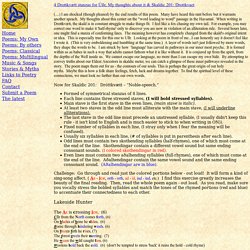
I am shocked (though pleased) by the end results of this poem. Many have heard this rant before but it warrants another speach. My thoughts about this center on the "word leading to word" passage in the Havamal. When writing in Drottkvætt, the skald is in constant struggle to make things fit. I feel like a fox chasing my own tail. Now for Skaldic 201: Dróttkvætt – “Noble-speech.” Formed of symmetrical stanzas of 8 lines. Challenge: Go through and read just the colored portions below - out loud! Lakeside Hunter The Ás is crossing ice, (6) From a scifi story in an anthology. Another. Another. Another. Music for drottkvaett. A cultural translation project. The Department of Anglo-Saxon, Norse and Celtic (ASNC), University of Cambridge, is offering poets an exciting opportunity to get involved in the cultural translation project Modern Poets on Viking Poetry as part of an Arts and Humanities Research Council pilot scheme.

Skaldic poetry encompasses particular types of verse composed in Old Norse (medieval Scandinavian) from the ninth to fourteenth century. It is often characterised by its complex metrical structures, its riddling syntax, and the liberal application of a distinctive type of metaphor known as the kenning. The wonderful richness of wordplay, imagery, ambiguity and irony at play in skaldic poetry has a great deal to offer poets composing in other cultural contexts. The project Modern Poets on Viking Poetry aims to cultivate contemporary poets’ awareness of the skaldic aesthetic, nurturing a dialogue between academic research and modern poetic practice. The project’s modus operandi will be as follows: Thesis on skaldic slam. Reek-seether. Yes, volcanos.
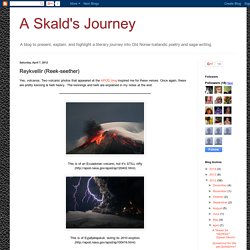
Two volcanic photos that appeared at the APOD blog inspired me for these verses. Once again, these are pretty kenning & heiti heavy. The kennings and heiti are explained in my notes at the end. This is of an Ecuadorian volcano, but it's STILL nifty ( Writing Poetry in Old Norse Meters Jon Cyr. A decent imitation. Burt Beckmann Next to the surf-road six sat late, thinking we’d found out a fine hideaway.

The ladies were laughing, lapping up beer, we warriors were not woman weary. Pleasant that party until the lager made the girls piss. Staggering, giggling down the dunes they descended, hardly aware of Howie. There as they squatted his squad car came sneaking: in floodlights the females were framed. Meanwhile, hearing the hassle we hastened to see how things stood, our odds in the fist-storm. I remember our ranks, brutal in gang-play: no bolder berserks than Ratzo and goat-bearded Jim. Already the ravens were rending the cowards to bits, in our minds we saw wolves making short work of wounded foes, crabs clipping at corpse flesh, when around us arose those sons of trolls. Capture brings credit to none. But the first to fall was fierce James, lord of hard liquors, lightning-quick drinker. Escape was not easy on that escapade. One of mine from '97.
Auden's attempt. SKALD - Viking Poems. Drottkvaett and lojban. [from ju'i lobypli number 10: November-December 1989] Skaldic Poetry and Lojban, by Athelstan Berfoetskald English speakers may be unaware of the wealth of possible forms of poetry that exist in the world's literature.
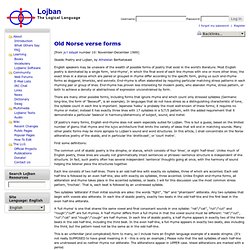
Most English poetry is dominated by a single form, 'end-rhyme', in which the final word of each line rhymes with one or more other lines; the exact lines in a stanza which are paired or grouped in rhyme differ according to the specific form, giving us such end-rhyme forms as doggerel, limericks, and sonnets. End-rhyme is often elaborated by requiring particular matching stress patterns in each rhyming pair or group of lines. End-rhyme has proven less interesting for modern poets, who abandon rhyme, stress pattern, or both to achieve a density or abstractness of expression unconstrained by form. There are many other possible forms, including forms that ignore rhyme and which count only stressed syllables (Germanic long-line, the form of "Beowulf", is an example). ... !)
1. Drottkvaett for dummies. "drottkvaett for dummies: the simplified documentation" In order to understand Viking poetry it is required that the casual reader understand poetry, both what it is, and written in its most simplistic form.
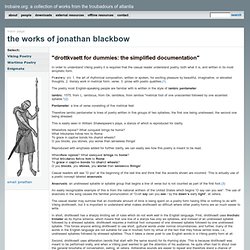
Po●et●ry: (n): 1. the art of rhythmical composition, written or spoken, for exciting pleasure by beautiful, imaginative, or elevated thoughts. 2. literary work in metrical form; verse. 3. prose with poetic qualities.(1) Skaldic poetry. Here are some thoughts I had about Skaldic poetry: Skaldic poetry was a form of poetry used by the Old Norse or Viking poets, called Skalds, during and after the Viking era.
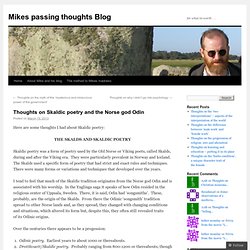
They were particularly prevalent in Norway and Iceland. The Skalds used a specific form of poetry that had strict and exact rules and techniques. There were many forms or variations and techniques that developed over the years. I tend to feel that much of the Skaldic tradition originates from the Norse god Odin and is associated with his worship. Over the centuries there appears to be a progession: